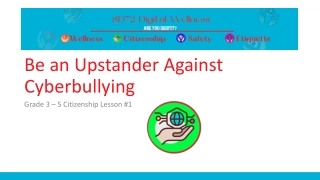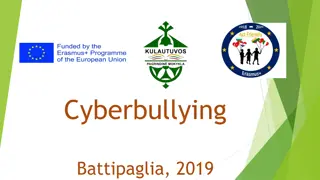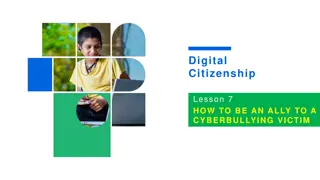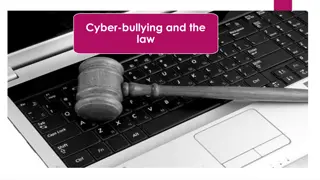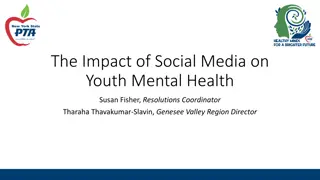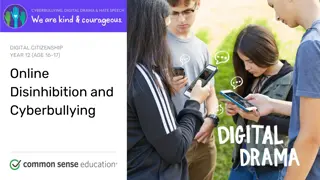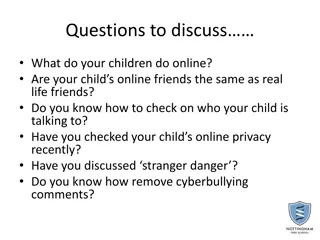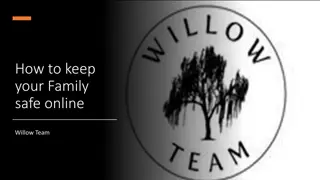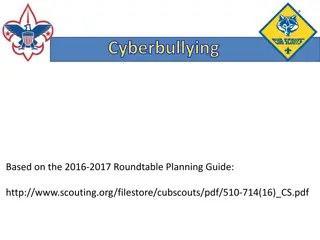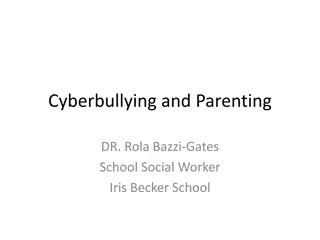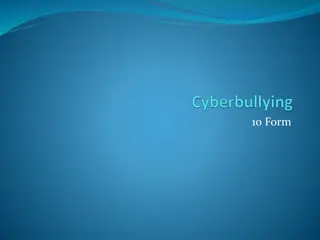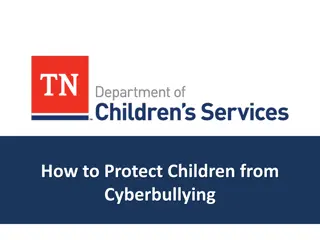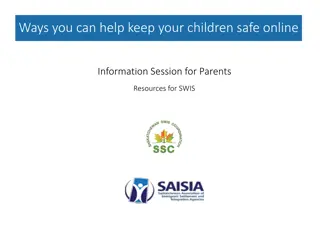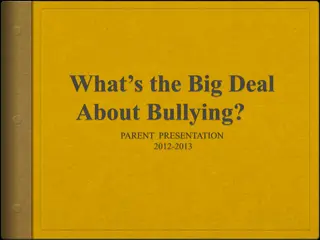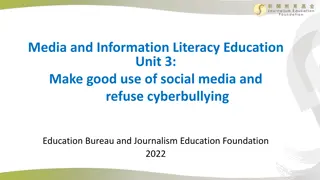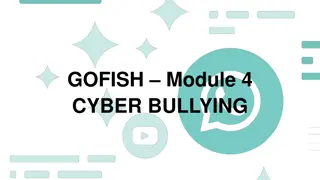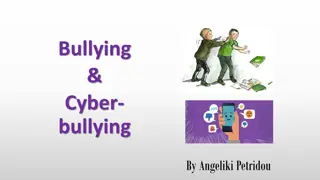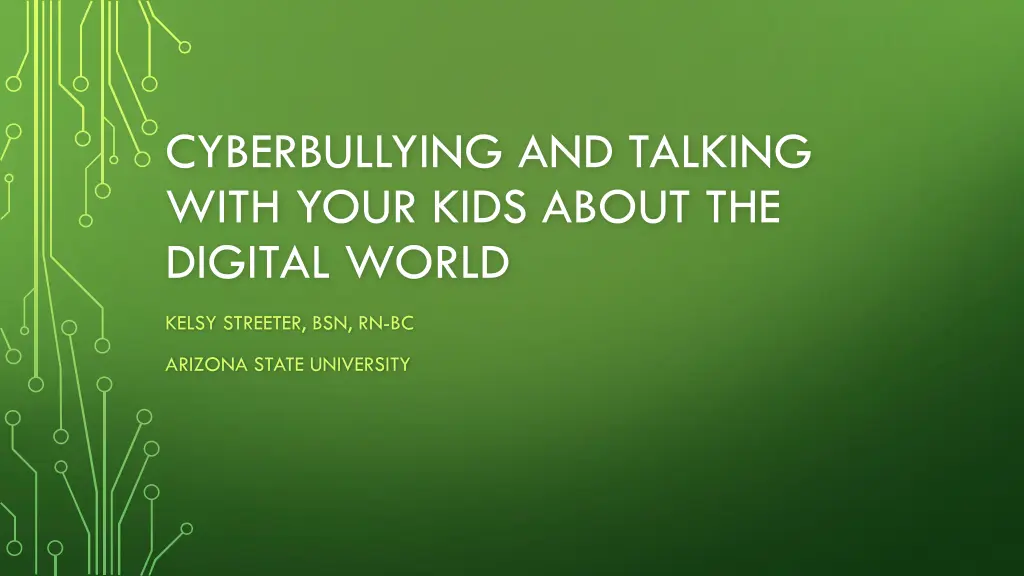
Understanding Cyberbullying and Engaging Kids in the Digital World
Explore the world of cyberbullying, its key traits, examples, and impacts on victims. Learn how cyberbullying differs from traditional bullying, and discover effective ways to talk to kids about this important issue in the digital age.
Download Presentation

Please find below an Image/Link to download the presentation.
The content on the website is provided AS IS for your information and personal use only. It may not be sold, licensed, or shared on other websites without obtaining consent from the author. If you encounter any issues during the download, it is possible that the publisher has removed the file from their server.
You are allowed to download the files provided on this website for personal or commercial use, subject to the condition that they are used lawfully. All files are the property of their respective owners.
The content on the website is provided AS IS for your information and personal use only. It may not be sold, licensed, or shared on other websites without obtaining consent from the author.
E N D
Presentation Transcript
CYBERBULLYING AND TALKING WITH YOUR KIDS ABOUT THE DIGITAL WORLD KELSY STREETER, BSN, RN-BC ARIZONA STATE UNIVERSITY
WHAT IS CYBERBULLYING? Cyberbullying (CB) is bullying through electronic communication technologies Key traits of bullying Repetition Intentionally being mean, rude or offensive Bully has power over the victim The intent is usually to make the victim feel sad, scared, upset, or angry. Forms: Text messages, chat, social media, apps, websites, email 15-25% of children have experienced it (Kowalski, Giumetti, Schroeder, & Lattanner, 2014)
WHAT IT IS AND WHAT IT ISNT Examples of CB: Cruel remarks Excluding, isolating, or systematically ignoring Intimidation/threats Harassment Offensive messages/posts Impersonating victim Spreading rumors Sharing private information or embarrassing pics or videos What isn t CB: One off fights over the internet Playful teasing Serious threats to harm or kill another person Libel
WHAT MAKES CYBERBULLYING DIFFERENT? CB can expose the victim to a wide audience Peers can share messages with larger network CB can be sent and received 24/7 and reach the victim anywhere Home is not necessarily a safe place Bullies can remain anonymous and don t have to witness the effect on the victim Tendency of victim to become bully (Kowalski, Giumetti, Schroeder, & Lattanner, 2014)
EXAMPLES OF CYBERBULLYING Example: Creation of a website dedicated to making fun of a boy including involving other kids in making mean remarks about him. His email was also posted on the site so people could send him cruel emails.
VIDEO https://www.youtube.com/watch?v=-5PZ_Bh- M6o
AND NOW FOR SOMETHING COMPLETELY DIFFERENT: https://www.youtube.com/watch?v=EAcdvmnZ_GM
WHERE ARE THE KIDS AT? Social media: Facebook, Twitter, Ask.fm, Google+ Apps: Whatsapp, Snapchat, Vine, Yik Yak, Kik, Whisper Chat: Omegle, Burn Note (app), Chat Roulette Reality: it is difficult to stay on top of every single new site and app that kids are using. Sites like common sense media can help but these apps are constantly being developed and evolving Open communication is key! (Elgersma, C., 2016; Martin-Wilbourne Partners, 2015)
1. FACEBOOK Facebook.com, Facebook messenger app More than 1.65 billion people are active on Facebook At what age can kids start to join Facebook? 13, anyone under this age is not permitted However, kids can get an account by lying about their birth year Facebook is less popular with kids then it used to be. Why? Because parents are there too You might not be able to see everything your child posts Allows you to report bullying/harassment (Facebook, 2016)
2. INSTAGRAM Instagram.com, app 400 million active users monthly Platform for sharing pictures and videos with the public or friends. Users can like or comment on these posts. Also restricted to ages 13+ Allows you to report bullying/harassment Bullying: posting of malicious or embarrassing pics/video; captioning photos to imply they are representative of a victim; mean or rude comments; using hurtful hashtags; impersonation (Cyberbullying Research Center, 2013; Instagram, 2016)
App MAYBE 100 million active users monthly (Nusca, 2015) Also restricted to 13+ Videos can be set to disappear in 10 seconds or less but 3. SNAPCHAT https://www.youtube.com/watch?v=q4tSh-WLXc4&spfreload=10
OPENING UP THE CONVERSATION ON INTERNET USE AND CYBERBULLYING I heard about an app/site called ______. Are any of your friends using it? Ask them to show you how to use an app or do something on it Sit down with your child at the computer or with other devices and ask them to show you what sites and apps they like. What do you like about this site/app? Is there anything about it you don t like or that makes you feel bad? Has anyone ever posted anything about you or sent you a message that made you feel hurt or angry? Family Online Safety Contract: https://www.fosi.org/good-digital-parenting/family-online- safety-contract/
WHAT TO DISCUSS? What you consider to be acceptable and unacceptable behavior online How to be safe online: privacy settings, choosing friends To think before you post anything What sites are off limits Cyberbullying and what it is; consequences for cyberbullying To come to you if someone is making them feel unsafe or is bullying them over electronic communication Reassure them that you will be supportive if they re being bullied (National Society for the Prevention of Cruelty to Children, 2016)
SIGNS THAT A CHILD IS BEING BULLIED Anger, sadness or frustration after having been on their device or online. Uneasiness about going to school or spending time with peers or sudden difficulties in school. Suddenly stops going on the internet, social media sites/apps, or using devices. Deletes accounts. Withdrawn from friends and family. Nervous about getting online or using device. Avoids talking about what they re doing online. Loss of interest in things they used to enjoy. (Get Cyber Safe, 2015a)
WHAT TO DO WHEN YOUR CHILD IS BEING CYBERBULLIED If there is a real threat to your child s safety get the authorities involved immediately Inform the school if both children attend the same school. Encourage them to seek support from friends Neither you nor your child should reply to the bully Do collect evidence of CB Block the bully Improve privacy and security measures for sites and apps. Do report the message to the site or online service provider if what they re doing violates terms of service Contact information: cyberbullying.us/report (Hinduja & Patchin, 2015a)
SIGNS THAT A CHILD MIGHT BE CYBERBULLYING Laughing hard when using device but not willing to show or tell you what they re laughing about. Quickly hiding device or closing internet windows when you enter the room. Avoids talking about what they do online. Getting in trouble at home or school often. Don t care if what they say or do hurts others. Increased preoccupation with being popular. Multiple online accounts or being on accounts that aren t there s. Spending a lot of time online and obsessively checking devices. (Get Cyber Safe, 2015b)
WHAT TO DO WHEN YOUR CHILD IS CYBERBULLYING Acknowledge that there is a problem Reassure your child that your available to talk if they are being bullied Immediately stop the bullying Please remember that hurt people hurt people Monitor their activities: https://www.commonsensemedia.org/blog/everything-you- need-to-know-about-parental-controls Help your child to understand how the victim feels (Hinduja & Patchin, 2015b)
RESOURCES Common Sense Media: commonsensemedia.org StopBullying.gov Facebook s help center Cyberbullying Research Center: Cyberbullying.org
KIDS DO GOOD THINGS ONLINE TOO https://www.youtube.com/watch?v=rpOvYWd4KW4
REFERENCES Cyberbullying Research Center (2013). Cyberbullying on Instagram. Retrieved from http://cyberbullying.org/cyberbullying-on-instagram Elgersma, C. (2016). 16 apps and websites kids are heading to after Facebook. Retrieved from https://www.commonsensemedia.org/blog/16-apps-and-websites-kids-are-heading- to-after-facebook Facebook (2016). Company info. Retrieved from http://newsroom.fb.com/company-info/ Get Cyber Safe (2015a). Is your child being cyberbullied? Retrieved from http://www.getcybersafe.gc.ca/cnt/cbrbllng/prnts/chld-bng-cbrblld-en.aspx Get Cyber Safe (2015b). Is you child cyberbullying? Retrieved from http://www.getcybersafe.gc.ca/cnt/cbrbllng/prnts/chld-cbrbll-en.aspx Hinduja, S. & Patchin, J.W. (2015a). What to do if you child is cyberbullied. Retrieved from http://cyberbullying.org/tips-for-parents-when-your-child-is-cyberbullied.pdf Hinduja, S. & Patchin, J.W. (2015b). What to do when your child cyberbullies others. Retrieved from http://cyberbullying.org/what-to-do-when-your-child-cyberbullies-others
REFERENCES Instagram (2016). Press news. Retrieved from https://www.instagram.com/press/?hl=en Kowalski, R.M., Giumetti, G.W., Schroeder, A.N., & Lattanner, E.R. (2014). Bullying in the digital age: A critical review and meta-analysis of cyberbullying research among youth. Psychological Bulleting, 140(4), 1073-1137. doi: 10.1037/a0035618 Martin-Wilbourne Partners (2015). Snapchat is now the third most popular social network among millennials. Retrieved from http://mwpartners.com/snapchat-is-now-the- third-most-popular-social-network-among-millennials/ National Society for the Prevention of Cruelty to Children (2016). Discussing online safety with your child. Retrieved from https://www.nspcc.org.uk/preventing- abuse/keeping-children-safe/online-safety/talking-your-child-staying-safe-online/ Nusca, A, (2015). Why Snapchat is worth $19 billion (or more). Retrieved from http://fortune.com/2015/02/19/snapchat-worth-19-billion-more/


